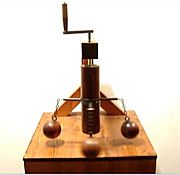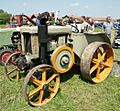Flywheel facts for kids

A flywheel is a heavy disk or wheel that spins very fast. It's connected to a spinning rod called a shaft. Think of it like a super-powered spinning top! Flywheels are used to store energy from movement, which we call kinetic energy.
Because a flywheel is heavy and spins fast, it doesn't like to change its speed easily. This helps to keep the shaft spinning at a steady speed. Imagine a car engine: sometimes it gets a burst of power, and sometimes less. This can make the engine's spinning uneven. A flywheel helps smooth out these changes, making the engine run much more steadily. Many engines, especially those with pistons, use flywheels to solve this problem.
Contents
How Flywheels Store Energy
It takes energy to make any wheel spin. Once it's spinning, especially if there's little friction, it will keep going for a long time. When you need that energy back, the flywheel can release it. This makes a flywheel a simple way to store energy mechanically.
The amount of energy a flywheel can store depends on a few things:
- How heavy it is: A heavier flywheel can store more energy.
- How fast it spins: The faster it spins, the more energy it holds.
- Its size (radius): Parts of the wheel farther from the center store more energy.
Flywheels are specially designed to store a lot of energy. They are often made to be very heavy or to spin incredibly fast.
Flywheels in Action
A great example of flywheels in action is in some buses. When a bus stops, like at a traffic light, the energy from its slowing down wheels can be sent to a flywheel. This makes the bus slow down while the flywheel speeds up, storing that energy. Then, when the bus needs to start moving again, the energy from the flywheel is sent back to the wheels, helping the bus get going.
Since you wouldn't want a super heavy wheel on a bus, these special flywheels are made from lighter materials. These materials are strong enough to handle extremely fast spinning without breaking.
History of Flywheels
Flywheels have been around for a very long time! One of the oldest and most common examples is the potter's wheel. Potters used a heavy wheel that they spun to keep their clay turning smoothly while they shaped it.
During the Industrial Revolution, flywheels became even more important. James Watt, famous for his work on the steam engine, helped improve flywheels. His friend James Pickard also used flywheels in his inventions. They were key to making early machines run more smoothly and efficiently.
Images for kids
See also
 In Spanish: Volante de inercia para niños
In Spanish: Volante de inercia para niños




